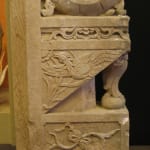A Pair of Ming Dynasty Sandstone Lion Tiles, 1368 CE - 1644 CE
Sandstone
17 x 48.2 x 6.2
DL.2101
Further images
Upon leading a victorious rebellion against the foreign Mongul rulers of the Yuan Dynasty, a peasant named Zhu Yuanzhang seized control of China and founded the Ming Dynasty in 1368....
Upon leading a victorious rebellion against the foreign Mongul rulers of the Yuan Dynasty, a peasant named Zhu Yuanzhang seized control of China and founded the Ming Dynasty in 1368. As emperor, he founded his capital at Nanjing and adopted the name Hongwu as his reign title. Hongwu, literally meaning “vast military,” reflects the increased prestige of the army during the Ming Dynasty. Culturally, the greatest innovation of the Ming Dynasty was the introduction of the novel. Developed from the folk tales of traditional storytellers, these works were transcribed in the everyday vernacular language of the people. Advances in printmaking and the increasing population of urban dwellers largely contributed to the success of these books. Architecturally, the most famous monument of the Ming Dynasty is surely the complex of temples and palaces known as the Forbidden City that was constructed in Beijing after the third ruler of the Ming Dynasty, Emperor Yongle, moved the capital there. Today, the Forbidden Palace remains one of the hallmarks of traditional Chinese architecture and is one of the most popular tourist destinations in the vast nation.
This fabulous pair of lion tiles date from this exciting chapter in China’s history. Originally they must have formed part of the architectural adornment of a palace or temple. The sculptor has exploited every available surface to showcase his skill. On the uppermost level a fierce Fu Lion (also known as a Fu Dog) keeps watch. While sculptures of Fu Dogs originally stood guard outside Buddhist temples, by the time of the Ming Dynasty, when this work was created, the dogs had lost most of their religious significance and were placed outside the entrances of homes and palaces out of custom. In this case the lions have been carved at a vertical angle, almost as if they are about to tumble over the edge in their excitement. On the next level down are roundels, within which small figures carry out a variety of pursuits. On the lower edge of these roundels the sculptor has included a charming detail; small fish, with each scale clearly defined, have been squeezed into the available space. Beneath this is a ledge, supported by a large lion paw. Beautiful floral motifs and a phoenix-like bird adorn the surface in low relief. The care taken over the details of these whimsical tiles implies that they were created at the request of an important patron.
This fabulous pair of lion tiles date from this exciting chapter in China’s history. Originally they must have formed part of the architectural adornment of a palace or temple. The sculptor has exploited every available surface to showcase his skill. On the uppermost level a fierce Fu Lion (also known as a Fu Dog) keeps watch. While sculptures of Fu Dogs originally stood guard outside Buddhist temples, by the time of the Ming Dynasty, when this work was created, the dogs had lost most of their religious significance and were placed outside the entrances of homes and palaces out of custom. In this case the lions have been carved at a vertical angle, almost as if they are about to tumble over the edge in their excitement. On the next level down are roundels, within which small figures carry out a variety of pursuits. On the lower edge of these roundels the sculptor has included a charming detail; small fish, with each scale clearly defined, have been squeezed into the available space. Beneath this is a ledge, supported by a large lion paw. Beautiful floral motifs and a phoenix-like bird adorn the surface in low relief. The care taken over the details of these whimsical tiles implies that they were created at the request of an important patron.







